#university of illinois rare book & manuscript library
Photo

Gwendolyn Brooks, June 7, 1917 / 2023
(image: Roy Lewis (photograph), Gwendolyn Brooks, Gwendolyn Brooks Collection, Rare Book & Manuscript Library, University of Illinois Urbana-Champaign, Champaign, IL)
#poetry#photography#gwendolyn brooks#birthday anniversary#roy lewis#gwendolyn brooks collection#university of illinois rare book & manuscript library#1910s#2020s
43 notes
·
View notes
Text
🖌🖍Downloadables/Coloring Sheet Sources!🎨✀
Another work project! Want to color?? Want to not spend crazy money on it?? Want to not use a site interface that prints a huge advertisement for their site all over the bottom?? Here’s a whole bunch just for you, because I care sm about this after hunting these down for hours
🎨 BIG SOURCES 🎨 :
#Color Our Collections (all institutions)
Crayola Coloring Pages (Disney, Adult, Seasons+)
http://www.supercoloring.com/
➡Browse by section, or use CRTL + F to search by keyword!⬅
🐱🐉Dinosaurs/Ancient Animals:
New Mexico Museum of Natural History
Natural History Museums of Los Angeles County
Sam Noble Museum
🌊Oceans:
Aquarium of New Zealand
Monterey Bay Aquarium
Harvard Museums of Science & Culture (lots of stuff tbh)
Médiathèque Jacques-Chirac, Troyes Champagne Métropole (people, nature, shell)
Children’s Creativity Museum (Halloween, Día de Los Muertos, Nature)
🦁Zoo:
Museum of Natural History (Mammals)
Museum of Natural History (Horse)
Museum of Natural History (k-2: all)
University of Alabama Museums (Patterns, Nature, Ancient tools)
University of Florida Department of Entomology and Nematology (BUGS!!)
Van Gogh Museum
Carnegie Museum of Natural History
Natural History Museums of Los Angeles County
Sam Noble Museum
National Cowboy and Western Heritage Museum (Horses) x
Scholastic (Butterfly, word activity)
💃🏽🕺🏽People:
Museum of Natural History (Horse)
Spy Museum (spy stuff)
Aerospace Museum (?) (Printables)
Colonial Williamsburg
NJ State House (...statues??)
Harvard Art Museums (ANCIENT EGYPT!!!!)
Harvard Museums of Science & Culture (lots of stuff tbh)
West Virginia & Regional History Center (Wizard of Oz)
AIA Nashville Parthenon (Ancient Greece)
Fairfield University Art Museum (History)
Escuela Superior de Artes de Yucatán (Latin American Culture)
Illinois Rare Book and Manuscript Library (Various Book Characters, Alice in Wonderland)
Médiathèque Jacques-Chirac, Troyes Champagne Métropole (people, nature, shell)
Russian Museum of Ethnography (Patterns)
Shelburne Museum (Pattern, animals, people)
Jagiellonian Library Coloring Book (Polish publications)
Rutgers University (NJ)
Museum für Kunst und Gewerbe Hamburg (Ancient Greece)
Jewish Museum of Maryland (fancy dresses)
Queens College (Music)
University of Alabama Museums (Patterns, Nature, Ancient tools)
Shangri La Museum of Islamic Art, Culture, and Design (Patterns)
Walters Art Museum (Ancient Greece, Alphons Mucha)
Van Gogh Museum
Hmong Museum (Hmong-American culture)
Children’s Creativity Museum (Halloween, Día de Los Muertos, Nature)
North Carolina Museum of History (Historical, Native Americans)
National Cowboy and Western Heritage Museum (Horses) x
Smithsonian/National Museum of African American History & Culture (Adinkra, Kwanzaa)
The Met (Ancient History, History, jewelry)
Studio Museum (African-American)
Los Angeles Public Library (Black History month, African American)
Kente Cloth Coloring Book (African/African American, patterns) (abbreviated)
Scholastic (Comic book/Superhero/writing)
🦋Nature:
Museum of Natural History (Moon) (Activity)
Aerospace Museum (?) (Printables)
Albert R. Mann Library (leaves etc.)
Harvard Museums of Science & Culture (lots of stuff tbh)
Médiathèque Jacques-Chirac, Troyes Champagne Métropole (people, nature, shell)
Wales Higher Education Library Forum
Bibliothèque et Archives nationales du Québec
The Huntington Library, Art Museum, and Botanical Gardens
University of Alabama Museums (Patterns, Nature, Ancient tools)
University of Florida Department of Entomology and Nematology (BUGS!!)
Van Gogh Museum
New Mexico Museum of Natural History
Natural History Museums of Los Angeles County
Sam Noble Museum
Children’s Creativity Museum (Halloween, Día de Los Muertos, Nature)
Scholastic (Butterfly, word activity)
📚“Storybook”:
Bibliothèque municipale de Toulouse (Rabbits dressed as people)
West Virginia & Regional History Center (Wizard of Oz)
Illinois Rare Book and Manuscript Library (Various Book Characters, Alice in Wonderland)
Médiathèque Jacques-Chirac, Troyes Champagne Métropole (people, nature, shell)
Jagiellonian Library Coloring Book (Polish publication)
Wales Higher Education Library Forum
James Madison University Libraries
Frederick Warne & Co. (Beatrix Potter)
Newberry Library (Alice in Wonderland +)
Charles M Schulz Museum (Peanuts Characters!!)
Pete the Cat
Peppa Pig (Seasonal +)
Legos (Coloring Sheets, Puzzles)
Dragon Masters
Fly Guy (Prince Fly Guy)
Scholastic Asia (Fly Guy, My Little Pony, Bad Guys, Shopkins, Transformers, Clifford)
Eric Carle (Coloring sheets, puzzles, games)
PBS (Daniel Tiger, Sesame Street, +. Sorts by Show.)
🧵Patterns:
Russian Museum of Ethnography (Patterns)
Shelburne Museum (Pattern, animals, people)
The Huntington Library, Art Museum, and Botanical Gardens
University of Alabama Museums (Patterns, Nature, Ancient tools)
Shangri La Museum of Islamic Art, Culture, and Design (Patterns)
Penn Museum
North Carolina Museum of History (Historical, Native Americans)
Smithsonian/National Museum of African American History & Culture (Adinkra, Kwanzaa)
The Met (Ancient History, History, jewelry)
Kente Cloth Coloring Book (African/African American, patterns) (abbreviated)
Klutz (inspirational)
Klutz (Summer, Unicorn)
Crayola (Adult)
🃏Other:
Highlights Magazine
(Activities, puzzle, seasonal)
*
Yes this took me several hours yes this will have no benefit in the long run, pLEASE use this list for your programs or schools or classes or libraries or afterschool programs or your homeschooling or summer camp or daycare or whatever you do; these are all free and are often run by their own orgs so you don’t have to use janky websites to get nice ones. Enjoy!!
#ya librarian#youth services#library posting#free teacher resources#prek#i don't know what tags apply tbh#faer winds#long post
15 notes
·
View notes
Photo

2021 Nancy Mysel Grant Recipient Announced
The Film Noir Foundation is proud to announce the recipient of this year's $5,000 FNF/Nancy Mysel Legacy Grant—Ari Negovschi.
Ari Negovschi is the Media Preservation Graduate Assistant for the Rare Book and Manuscript Library at the University of Illinois at Urbana-Champaign. She is overseeing the preservation of the Perry Miller Adato film collection. (Ms. Adato was the first female director to receive an award from the Director's Guild of America for her 1978 film Georgia O'Keefe and whose subjects included Gertrude Stein and Pablo Picasso.)
She has worked at the Autry Museum as an Exhibition Media Production Assistant for the award-winning Floral Journey: Native North American Beadwork, the 52nd Chicago International Film Festival, and as an Audio/Video Transfer Specialist at a Chicago-based digitization firm. As a transfer specialist, she developed a passion for hidden collections while digitizing historically significant personal, industrial, and cultural films. Inspired by her time working on the Adato collection, Ari hopes to continue canonizing work by female directors through film preservation.
The FNF's charitable grant, funded by the Mysel family in honor of the late film preservationist Nancy Mysel who supervised FNF restorations of The Prowler and Cry Danger, grants funding to students enrolled in film restoration and preservation studies. The FNF congratulates Ari on her grant award!
6 notes
·
View notes
Text
Essex Hemphill

Essex Hemphill (April 16, 1957 – November 4, 1995) was an openly gay American poet and activist. He is known for his contributions to the Washington, D.C. art scene in the 1980s, and for openly discussing the topics pertinent to the African-American gay community.
Biography
Early life
Essex Hemphill was born April 16, 1957, in Chicago, Illinois, to Warren and Mantalene Hemphill, and was the second eldest of five children. Early in his life, he moved to Washington D.C. where he attended Ballou High School. He began writing poetry at the age of fourteen, writing about his own thoughts, family life, and budding sexuality. After graduation, he enrolled at the University of Maryland in 1975 to study journalism. Though he left college after his freshman year, he continued to interact with the D.C. art scene: performing spoken word, working on journals, and beginning to publish his first poetry chapbooks. He would go on to achieve his degree in English at the University of the District of Columbia.
Career
In 1979, Hemphill and his colleagues started the Nethula Journal of Contemporary Literature, a publication aimed at showcasing the works of modern black artists. One of his first public readings was arranged by Nethula co-editor E. Ethelbert Miller at Howard University’s Founder Library where he performed beside and befriended filmmaker Michelle Parkerson. He also performed at other institutions, including Harvard University, University of Pennsylvania, and University of California at Los Angeles to name a few.
In 1982, Essex Hemphill, Larry Duckett, his close friend, and Wayson Jones, his university roommate, founded the spoken word group called "Cinque," which performed in the Washington D.C. area. Hemphill continued performing his rhythmic, spoken word poetry, and in 1983, received a grant from Washington Project for the Arts to perform an "experimental dramatization" of poetry entitled Murder on Glass, alongside Parkerson and Jones. Hemphill also began publishing his own collections of poetry during this time, beginning with Diamonds Was in the Kitty and Some of the People We Love (1982), and followed by the more favorably reviewed Earth Life (1985) and Conditions (1986). He would garner more national attention when his work was included in In the Life (1986), an anthology of poems from black, gay artists, compiled by Hemphill's good friend, lover, and fellow author, Joseph F. Beam. His poetry has been published widely in journals, and his essays have appeared in Obsidian, Black Scholar, CALLALOO, and Essence among others. In 1986, Hemphill received a fellowship in poetry from the National Endowment for the Arts.
Essex Hemphill also made appearances in a number of documentaries between 1989 and 1992. In 1989, he appeared in Looking for Langston, a film directed by Isaac Julien about poet Langston Hughes and the Harlem Renaissance. Hemphill also worked with Emmy award-winning filmmaker Marlon Riggs on two documentaries:Tongues Untied (1989) which looked into the complex overlapping of black and queer identities, and Black is... Black Ain't (1992) which discussed what exactly constitutes "blackness."
After Beam's death from AIDS in 1988, Essex Hemphill and Beam's mother worked conjointly in order to publish his sequel to In the Life. The second manuscript was published in 1991 under the title Brother to Brother: New Writings by Black Gay Men, which archived the works of about three dozen authors, including Hemphill himself. Writing about Hemphill and Beam in his book, Evidence of Being: The Black Gay Cultural Renaissance and the Politics of Violence, Darius Bost notes that Hemphill moved in with Beam's mother to help finish the anthology, taking on domestic tasks in exchange for room and board. He writes that Hemphill said in an interview that the anthology “was produced in the ‘context of confronting AIDS and the death around us. It’s almost like a fierce resistance that says, ‘Before I die, I’m going to say these things.’’” Hemphill also wrote a poem dedicated to Beam after his death titled “When My Brother Fell,” and dedicated his 1986 poem “Heavy Corners” to him. In 1990, he gave a speech at the OutWrite conference (where he was the only Black panelist), which eventually became the introduction to the anthology. Brother to Brother would go on to win a Lambda Literary Award.
In 1992, Hemphill published his largest collection of poetry and short stories, entitled Ceremonies: Prose and Poetry, which included recent work, but also selection from his earlier poetry collections, Earth Life and Conditions. The next year, the anthology would be awarded the National Library Association's Gay, Lesbian, and Bisexual New Author Award and a Pew Charitable Trust Fellowship in the Arts. In 1993, he was a visiting scholar at the Getty Center.
Death
In the 1990s, Hemphill would rarely give information about his health, although he would occasionally talk about "being a person with AIDS." It was not until 1994 that he wrote about his experiences with the disease in his poem "Vital Signs." He died on November 4, 1995, of AIDS-related complications.
Legacy
After his death on December 10, 1995, this day was announced by three organizations (Gay Men of African Descent (GMAD), Other Countries, and Black Nations/Queer Nations?) to be a National Day of Remembrance for Essex Hemphill at New York City's Lesbian and Gay Community Services Center.
In his essay "(Re)- Recalling Essex Hemphill" in Words to Our Now, Thomas Glave, pays tribute to Hemphill's life, focusing on the lasting effects of his actions. Glave writes:
In this now, we celebrate your life and language Essex. So celebrating, we know that we re-call you in what is largely, to borrow from another visionary, a 'giantless time.' The sheer giantry of your breathing presence has passed. Now present and future warriors—ourselves and others—will be compelled to learn, as you did and made manifest, that all hauls toward truth—toward venality; ardor, not arrogance; forthrightness, not cowardice.
In 2014, Martin Duberman wrote Hold Tight Gently: Michael Callen, Essex Hemphill, and the Battlefield of AIDS in which Duberman documents the life of Essex Hemphill, along with author and activist, Michael Callen. The book would go on to win the Lambda Literary Award for LGBT Nonfiction.
In June 2019, Hemphill was one of the inaugural fifty American “pioneers, trailblazers, and heroes” inducted on the National LGBTQ Wall of Honor within the Stonewall National Monument (SNM) in New York City’s Stonewall Inn. The SNM is the first U.S. national monument dedicated to LGBTQ rights and history, and the wall’s unveiling was timed to take place during the 50th anniversary of the Stonewall riots.
Works
Themes
Much of Hemphill's poetry and spoken word was autobiographical, and portrayed his experiences as a minority in both the African-American and LGBT communities.
He wrote pieces such as "Family Jewels," which conveyed his frustrations about white bigotry, specifically within the gay community. In his essay "Does Your Momma Know About me?" Hemphill criticizes photographer Robert Mapplethorpe's The Black Book, which showcased pictures of the penises of black men. Hemphill argued that excluding the faces of the black male subjects demonstrated the fetishism of African Americans by whites in the gay community.
The poems and essays in Ceremonies address the sexual objectification of black men in white culture, relationships among gay black men and non-gay black men, HIV/AIDS in the black community and the meaning of family. He also goes on to critique both the institutionalized patriarchy, and dominant gender identities within society.
Hemphill repeatedly invoked loneliness throughout his work. Loneliness in Hemphill's work is a traumatic feeling, a constant sense of rejection. Many of the men returned home after being rejected by white gay communities, only to be rejected within black communities as well. In Hemphill's poetry, he portrays loneliness as a collective feeling. He defined loneliness as a sense of being, marked by suffering without public recognition. A sense of separation from the public creates a social longing because even though the journey is lonesome, fighting against that journey not to kill you, as Hemphill said in one of his poems, makes you yearn for community and support.
Essays
(essay in) Patrick Merla (ed.), Boys Like Us: Gay Writers Tell Their Coming Out Stories, Avon Books. 1996
(essays in) Thomas Avena (ed.), "Life Sentences: Writers, Artists, and AIDS", Mercury House. 1994
Ceremonies: Prose and Poetry, 1992; Cleis Press, 2000, ISBN 9781573441018
Conditions: Poems, Be Bop Books, 1986
Anthologies
In the Life
Gay and Lesbian Poetry in Our Time
Art Against Apartheid
Men and Intimacy
New Men
New Minds
Natives
Tourists and Other Mysteries
(ed.) Brother to Brother: New Writings by Black Gay Men, 1991; RedBone Press, 2007, ISBN 9780978625115
Appearances
Looking for Langston (1989)
Tongues Untied (1989)
Black Is...Black Ain't (1994)
Narrator: Out of the Shadows, AIDS documentary
5 notes
·
View notes
Text
Wynkyn de Worde's "The boke of Chaucer named Caunterbury tales"
written by Katie Funderberg
Although less momentous than William Caxton’s first edition and certainly less ornate than the later Kelmscott Chaucer, Wynkyn de Worde’s The boke of Chaucer named Caunterbury tales (Incunabula Q. 821 C39c 1498) provides valuable insight into early English print history. As one of the most prolific English printers at the turn of the 16th century, de Worde’s initial years in the book trade—including the printing of the 1498 The boke of Chaucer—merit careful consideration. The University of Illinois at Urbana-Champaign’s copy, housed in the incunabula collection at the Rare Books and Manuscript Library, is a particularly useful case study example of de Worde’s early career at Westminster, as it is one of the most complete of the six copies known to exist. While several copies consist of only a few leaves, the volume owned by the RBML has 113 of the original 153 folia. Additionally, the leaves missing from the RBML copy were replaced with facsimiles produced by the British Museum in 1886, offering evidence of late 19th century attempts at book conservation as well as further information about the volume’s provenance.

According to the cataloger’s note in the page gutter of RBML’s copy, the university purchased The boke of Chaucer from Stonehill in 1956, over 450 years after its printing. The additional material pasted onto the front flyleaves make it clear that the book was previously owned by the British Museum before coming to reside in the Rare Book and Manuscript Library. On the recto of the second front flyleaf, there is a bill from Daniel C. Baxter to Major C. H. Fisher dated January 27, 1886 listing the charges for the facsimile leaves and woodcuts. The bill comes to a total of nine pounds, twelve shillings, and nine pence, with individual charges such as, “40,713 words, or 565 ½ folios, in ordinary writing at 2d per folio” costing £4.14.3 and “17 tracings of woodcuts in facsimile (charged for by time)” being £2.0.0. More information is provided on the recto of the fifth flyleaf in a short note dated January 28, 1886 and signed “Edward Ernest Stride, British Museum,” which reads: “The leaves supplied in MS. and the tracings of the woodcuts & of the printer's mark have been executed by Mr D. C. Baxter, of the Dept. of Printed Books, British Museum.” Additionally, on the recto of the fourth flyleaf, someone—presumably Baxter—has written, “The following memorandum is pasted into the copy of this work in the British Museum, and is believed to have been inserted by Sir Thomas Grenville; who bequeathed this work with his library, to the Museum,” indicating that the missing text and illustrations have been copied from The boke of Chaucer in the Grenville collection, currently housed at the British Library.

Although Grenville’s donation of The boke of Chaucer made the additions to the copy possible, the resulting facsimile text, done in a 19th century cursive hand, is jarringly different than the original text used by de Worde, especially when they appear together on the same leaf. Contrary to the typical goals of 21st century conservationists, Baxter was more concerned with preserving the literary narrative than the unique condition of the incunabula. The woodcuts, however, are well executed and, despite being obviously pasted in, closely resemble the printed illustrations. RBML’s copy has a contemporary binding of brown, blind-tooled calf over wooden boards with two brass clasps on the back board and evidence of two additional clasps on the front board. Based on the eight-petaled flower watermark found throughout the copy, The boke of Chaucer was printed on paper made by John Tate the Younger, owner of the first paper mill in England. Instead of importing paper from France like most English printers, de Worde used Tate’s paper for several books, including his 1495 English translation of De proprietatibus rerum, in which the verse epilogue “makes the first known mention of paper making in England” by referencing the work of John Tate the Younger.

Fortunately, the stable physical condition of the RBML copy of de Worde’s The boke of Chaucer allows the book to be regularly used in class sessions at the Rare Book and Manuscript Library. In addition to courses focusing on English print history, the copy is also utilized for more general typography and graphic design instruction. The RBML copy of The boke of Chaucer is evidence, not only of Wynkyn de Worde’s legacy as one of the forefathers of English printing, but also how later bibliophiles and book restorers engage with his early work.
24 notes
·
View notes
Text
Turning 21: The Transition from Territory to Statehood in Illinois
Illinois became the 21st state in the Union on December 3, 1818, making 2018 its Bicentennial year. This month we are joining other Chicago-area cultural heritage institutions in celebrating the Illinois' Bicentennial by hosing a special pop-up display of archival documents and rare books from our collections: correspondence, maps, books, and more that date to the time period when Illinois was transforming from French-held "Illinois Country" to the 21st state in the Union.
This exhibit is a part of Chicago Open Archives, a month-long series of events throughout the city and suburbs connecting community members with the collections, programs, and services of local archival repositories. Learn more at http://chicagoarchivists.org/coa
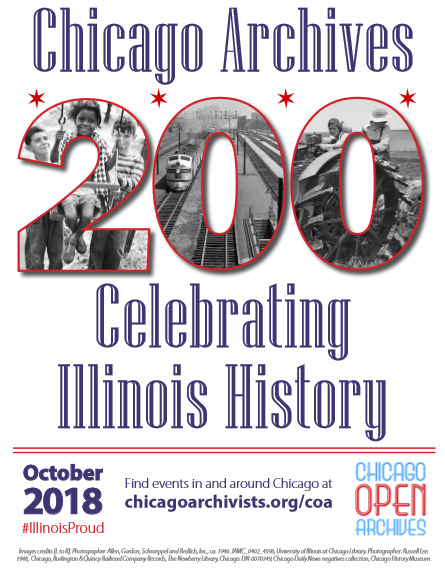
The physical exhibit of reproductions will be on display at the University of Chicago's Joseph Regenstein Library throughout the month of October, with some original materials on display in the Special Collections Research Center. For those of you who cannot visit in person, scroll down for a virtual view of our selections for this exhibit.
Transition from Territory to Statehood in Illinois
The oldest item displayed is a 1778 letter that was written when Illinois was a part of the American Revolutionary War's western theater. The letter, signed by George Wythe, George Mason, and Thomas Jefferson, congratulates George Rogers Clark on his appointment as the leader of a military expedition to the Northwest Territory. This was the beginning of a secret mission during the war later known as the Illinois Campaign, or Clark's Northwestern Campaign. Clark was ordered to seize control of Kaskaskia, Vincennes, and several other villages in French and British-held "Illinois Country." In the letter, the Virginia General Assembly mentions Native American raids in the territory which were instigated by the British. They also assure Clark that he and his soldiers will receive bounties of land as compensation. The nearby hand-drawn plat map demarcates the tract of 150,000 acres granted to Clark's soldiers in 1784.


Transcription of letter:
To George Rogers Clark Williamsburg Janry 3, 1776
Sir,
As some Indian Tribes to the westward of / the Missisippi have lately, without any provo- /cation massacred many of the Inhabitants upon / the Frontiers of this Commonwealth, in the / most cruel & barbarous manner, & it is intended / to revenge this injury & punish the Aggressors / by carrying the war into their own country. / We congratulate you upon your appoint / ment to conduct so important an Enterprize / in which we most heartily wish you / Success, and we have no Doubt that some / further reward in Lands in that country / will be given to the Volunteers who shall / engage in this Service, in addition to the / usual pay. If they are so fortunate to / Succeed, We think it just & reasonable that / each Volunteer entering[?] as a common Soldier in this Expedition, should be allowed three / hundred acres of Land, & the Officers in the / usual proportion, out of the Lands which may be conquered in the country now in / the possession of the said Indians; so as / not to interfere with the claims of any / friendly Indians, or of any people willing / to become Subjects of this Commonwealth, / and for this we think you may safely / confide in the justice & generosity of the / Virginia Assembly.
We are Sir Yr Most Hble. Servts
G. Wythe G. Mason Th. Jefferson
Letter from Virginia General Assembly to George Rogers Clark, January 3, 1778. Historical Manuscripts Collection, Box 24, Folder 15.
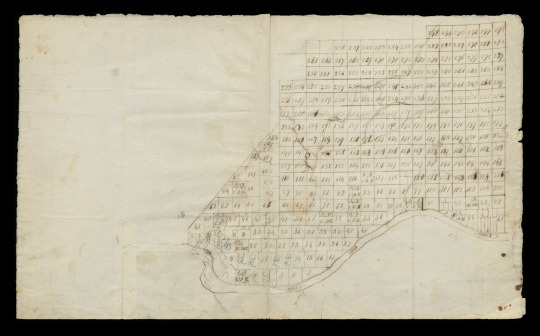
Plat of the Illinois Grant, 1784. Reuben T. Durrett Collection of Portraits, Illustrations, and Cartographic Material, Box 2, Folder 12.
Following the Revolutionary War, some, such as Gilbert Imlay, profited from the land grant system as surveyors. The 1797 edition of Imlay's popular A topographical description of the western territory of North America… served as an encyclopedia of North America for new settlers.
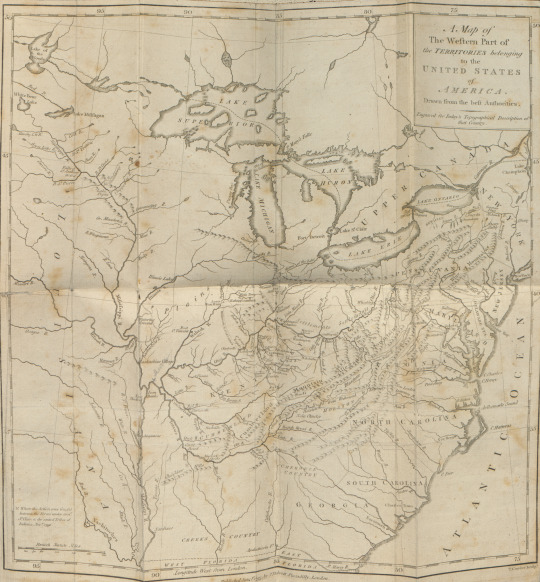
Imlay’s description of the Illinois country:
“The triangular tract of land at the head of this great vale, and between the Mississippi, the Ohio, and lake Erie (as that lake is vulgarly called), the country of the Illinois, is the finest spot of earth upon the globe, swelling with moderate hills, but no mountains, watered by the finest rivers, and of the most delightful climate; the soil, as appears from the woods with which it is clothed, is of the most abundant fruitfulness in vegetation. It abounds with coal; and there are multitudes of salt springs in all parts of it. There are mines of iron, copper, and lead. Wild rye grows here also spontaneously.” (p. 101)
Imlay’s Topographical description also reproduced the text of one Mr. Patrick Kennedy’s journal of an expedition in 1773 from Kaskaskia to the head of the Illinois river.

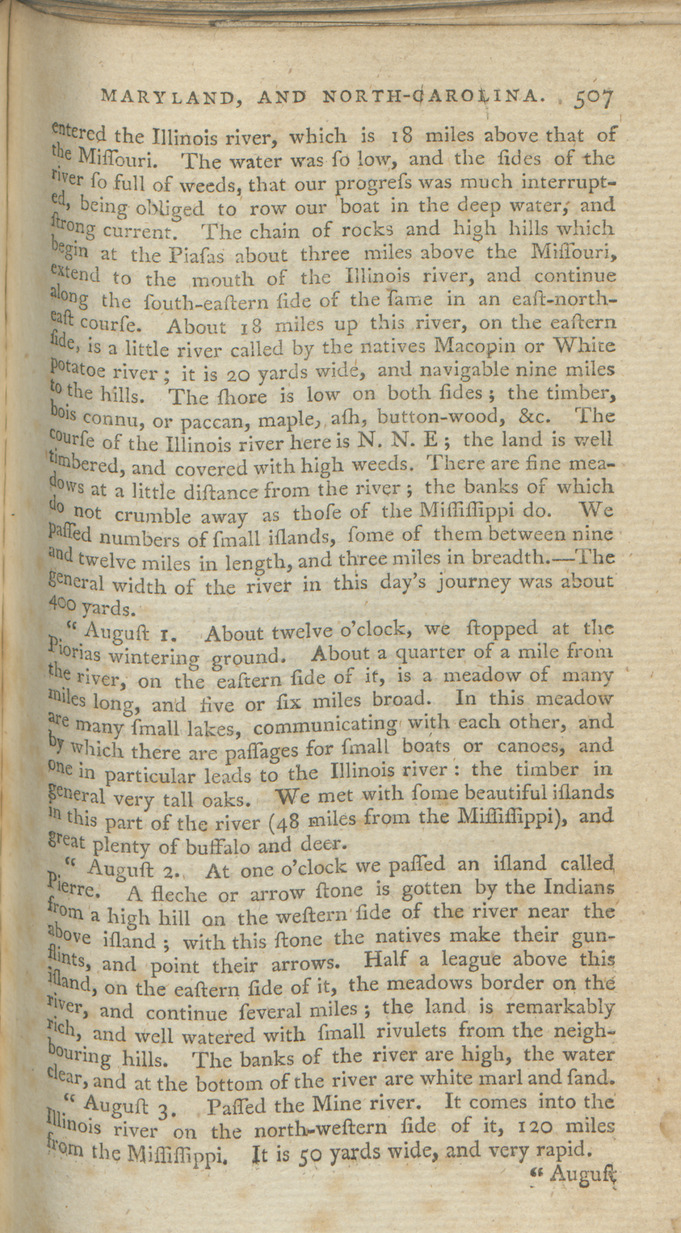
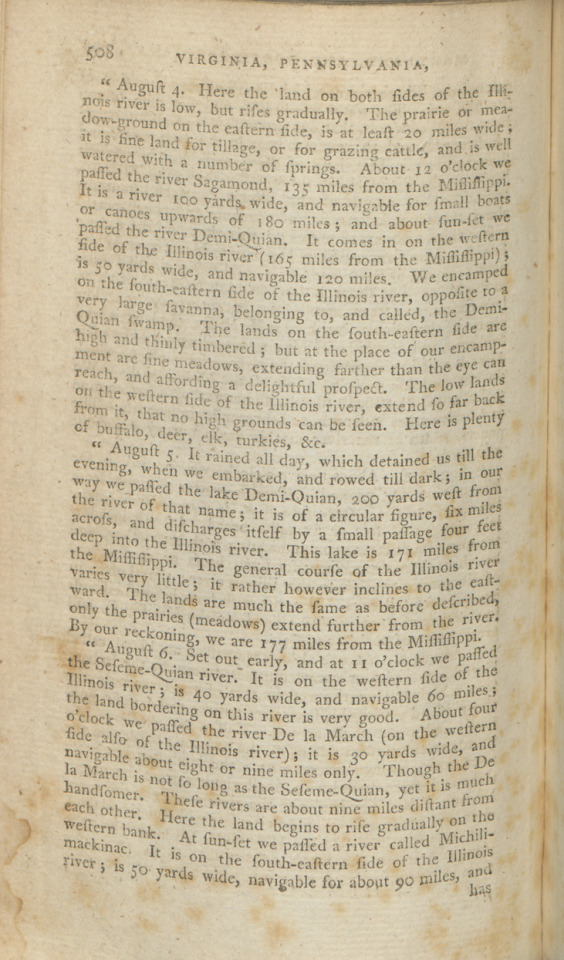

Imlay, Gilbert (1754?-1828?). A topographical description of the western territory of North America… London: Printed for J. Debrett, 1797. F352.I33 Rare c.1
The practice of granting Illinois land to volunteer soldiers continued in the War of 1812. American Nicholas Biddle van Zandt's 1818 Description of Military Lands describes three tracts of bounty lands, including the Illinois Military Tract which was situated between the Mississippi and Illinois rivers. The aim of Van Zandt’s text was to “give a faithful, a substantial, and, it is hoped, a satisfactory view of the Illinois and Missouri territories” and to aid settlers in selecting “the very spot upon which he may fix his habitation and his home.” Van Zandt also describes the Illinois Territory as a whole including an early description of the Chicago River and its potential as a “safe and commodious harbor for shipping” and the means by which the sand bank blocking the entrance to Lake Michigan might be removed.


Van Zandt, Nicholas Biddle. A full description of the soil, water, timber, and prairies of each lot, or quarter section of the Military Lands between the Mississippi and Illinois rivers. Washington City: Printed by P. Force, 1818. F547.M6 V28 1818 Rare c.1
Numerous accounts of the Illinois Territory were published, many with hopes of attracting emigrants. Irish author Thomas Ashe expounded upon the natural history of the area in Memoirs of mammoth, and various other extraordinary and stupendous bones…

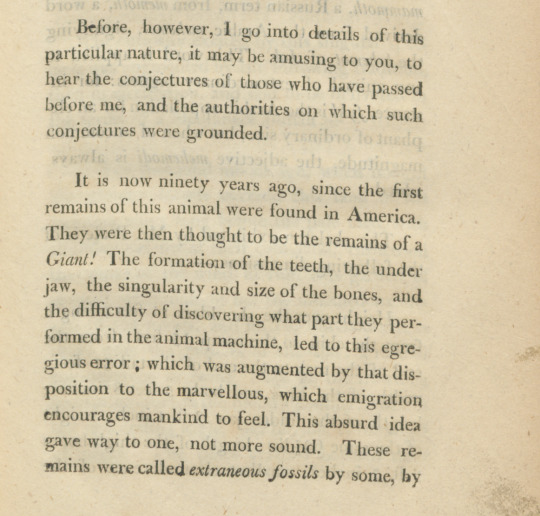

Ashe, Thomas (1770-1835). Memoirs of mammoth, and various other extraordinary and stupendous bones … found in the vicinity of the Ohio, Wabash, Illinois, Mississippi, Missouri, Osage, and Red Rivers. Liverpool: Printed by G. F. Harris, 1806. QE882.U7A8 Rare c.1
Adlard Welby’s A Visit to North America and the English Settlements in Illinois with a Winter Residence in Philadelphia included a description of the German settlement of Harmony, Illinois. Harmony was a settlement mostly comprised of poor Germans, though any person who agreed to live by the communal rules was allowed to join the community. The settlement lived by the principle of a communion of goods. That is, all of the harvested crops went into a communal store, and each person received the necessary amount of food. The tavern owner told author Adlard Welby: “We have every thing we can want, for our comfort and something more.”
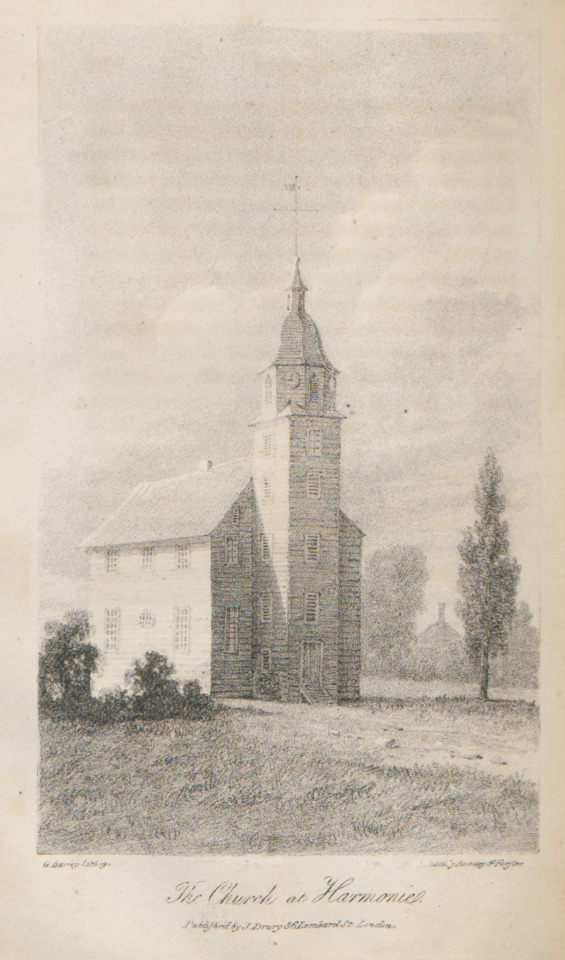
Welby, Adlard. A Visit to North America and the English Settlements in Illinois with a Winter Residence in Philadelphia. London: Printed for J. Drury, 1821. E41.W44 1821 Rare c.1
Morris Birkbeck, a British emigrant to the Illinois Territory who would later serve as Secretary of State of Illinois, described his American travel experiences and the establishment of the English Settlement, in Illinois Territory in Notes on a journey in America, from the coast of Virginia to the Territory of Illinois. First published in Philadelphia 1817, Notes, and its follow up, Letters from Illinois (1818), were wildly popular with multiple editions being published both in the United States and abroad, including multiple translations. The hand-colored map on display was published in the 1st London edition of Birkbeck’s Notes and includes all of the land traversed by Birkbeck’s party. Note the interesting placement of the borders of Indiana and the Illinois Territory; the location of Birkbeck’s settlement in the southeastern portion of the territory, on the Little Wabash River is captioned “The Prairie Settlement.”
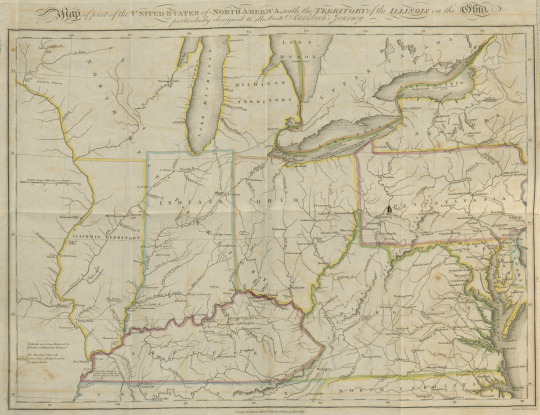

Birkbeck, Morris (1764-1825). Notes on a journey in America: from the coast of Virginia to the Territory of Illinois. London: Printed by Severn & Redington, for Ridgway and Sons, 1818. E162.B617 1818 Rare c.1
Birkbeck’s Letters from Illinois recounts his experiences living in the English Settlement and served to introduce Europeans (and hopefully convince them to emigrate) to the advantages of America.
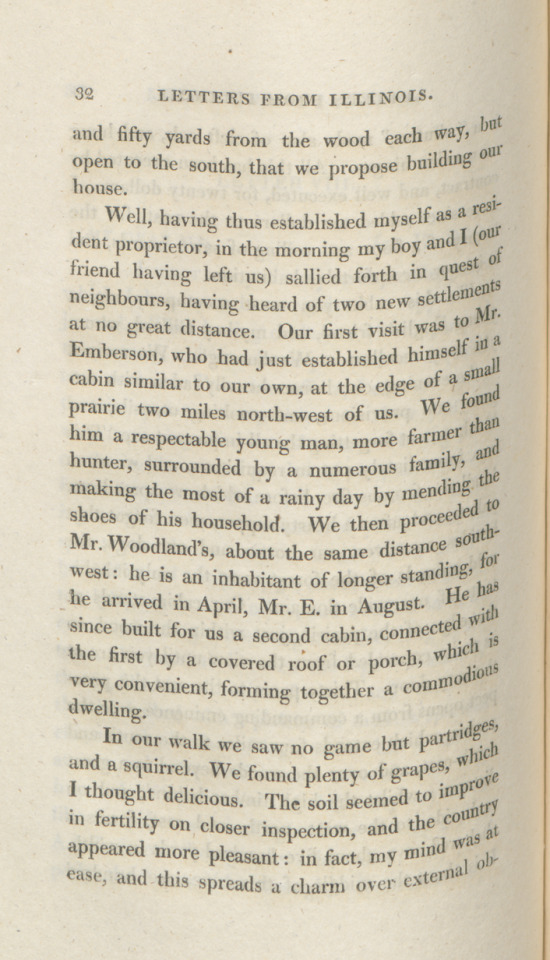
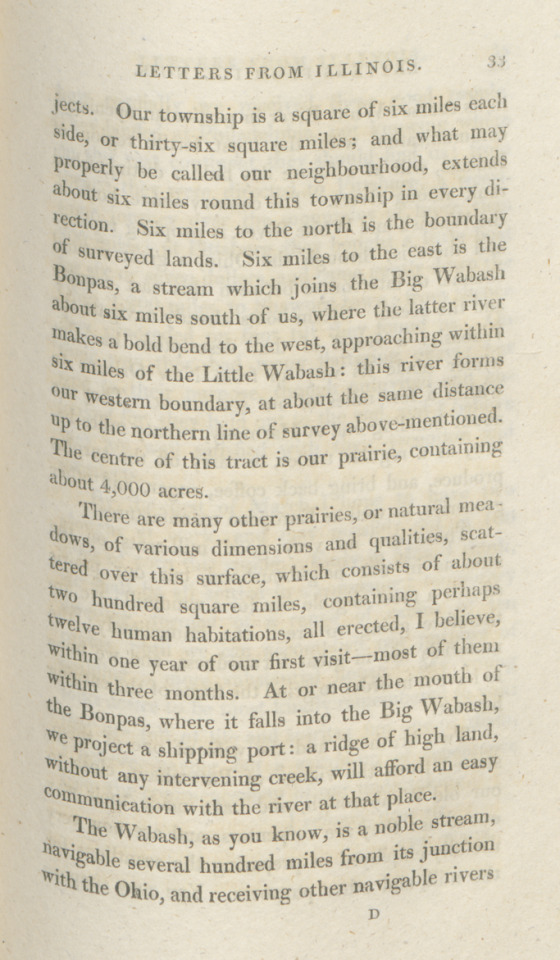

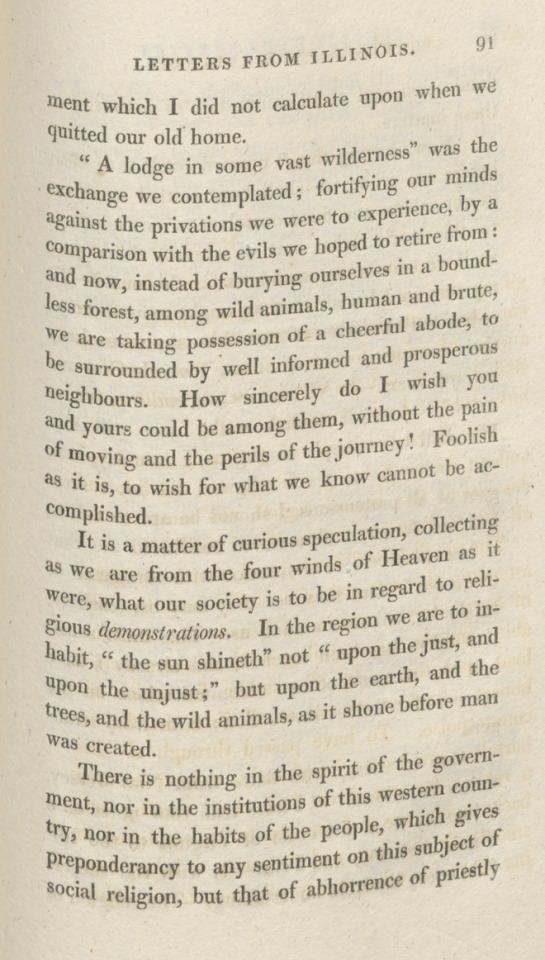
Birkbeck, Morris (1764-1825). Letters from Illinois. London: Printed for Taylor and Hessey, 1818. F545.B61 Rare c.1
British emigrant John Woods’ Two years’ residence describes his journey from England to the English Settlement in Illinois, along with the flora, fauna, agriculture, buildings, and business in the region. Woods' “Map of the allotments” shows the towns and ranges of the lower portion of Illinois.

Woods also provided a description of Birkbeck’s settlement, Wanborough:
“Mr. Birkbeck’s settlement, called Wanborough, is situated at the north-west corner of the English Prairie, and contains 25 cabins, a tavern, a store or two, and several lodging houses; and several carpenters, bricklayers, brick-makers, smiths, wheelwrights, and sawyers; also a taylor and butcher ... The building lots, at Wanborough, are some of five, and others of two and a half acres, laid out, like most of the American towns, in streets that cross each other at right angles, running north and south; the cross ones east and west. The lots are in the woods, but a considerable quantity of the wood is now cleared.” (p. 160-161)
Woods, John (-1829). Two years’ residence in the settlement on the English Prairie, in the Illinois country, United States: with an account of its animal and vegetable productions, agriculture, &c. &c., with the habits and customs of the back-woodsmen. London: Printed for Longman, Hurst, Rees, Orme, and Brown, 1822. F547.E2W9 1822 Rare c.2
As Illinois inched closer to statehood in 1817, Cook and Blackwell - the first printers in Illinois - published a list of laws, many to establish county seats and courthouses. (Cook County, Illinois is named for printer Daniel Cook).
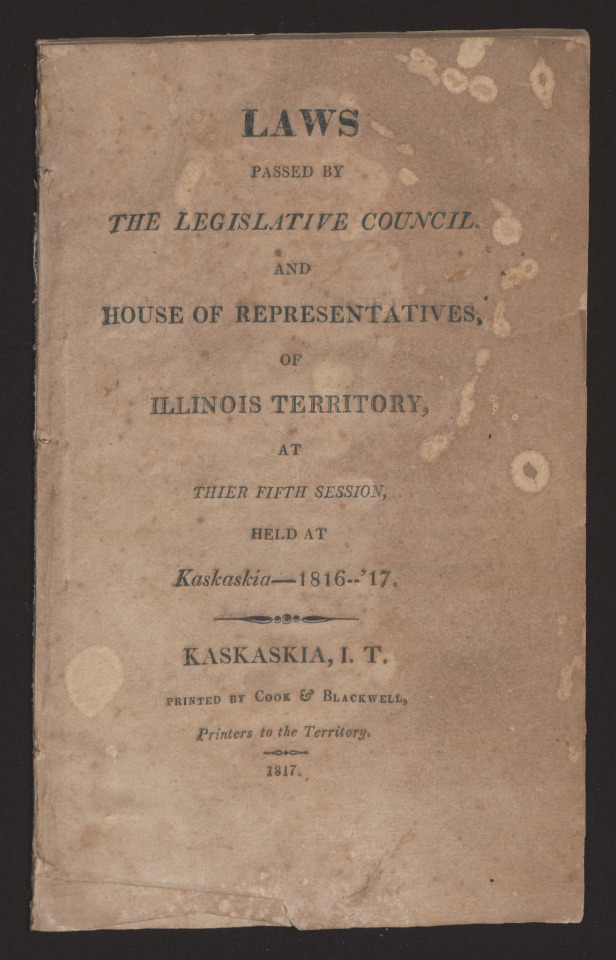
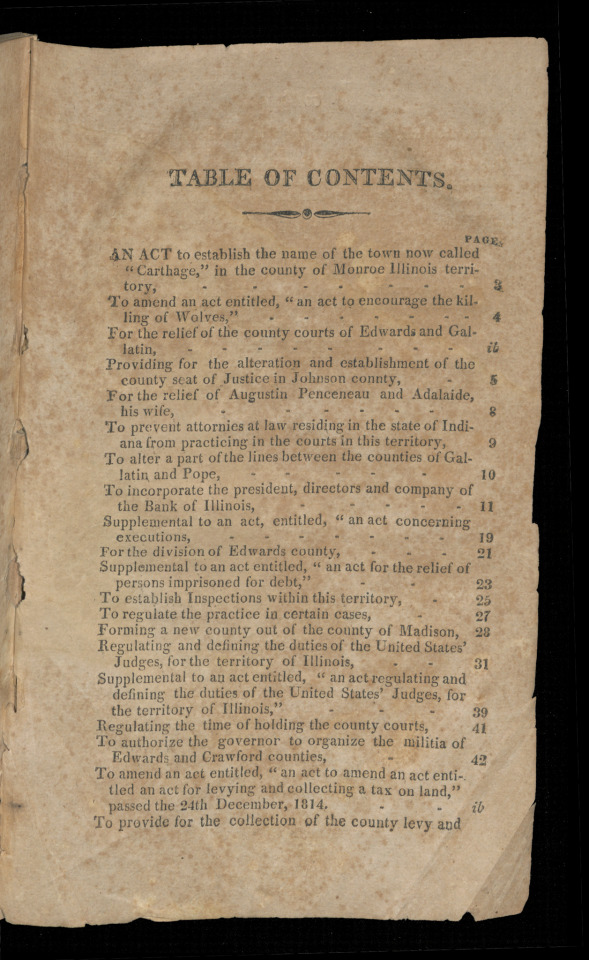
Laws passed by the Legislative council, and House of representatives, of Illinois territory, at their fifth session, held at Kaskaskia, 1816-'17. Kaskaskia, I.T.: Printed by Cook and Blackwell, printers to the territory, 1817. KFI1225.2 1816, Lincoln Collection
Counties and major cities in early Illinois were very different from what they are now. Kaskaskia was the capital of the Illinois Territory from 1809 to 1818. Located on the Mississippi River, it was flooded many times and the decision was made to move the capital to Vandalia in 1819, 70 miles northeast of St. Louis. Louis Beck's 1823 A gazetteer of the states of Illinois and Missouri… includes a plan for the new capital and the neighboring streets. It also describes Chicago as a small place of 10 or 15 homes in Pike County.


Beck, Lewis C. (1798-1853). A gazetteer of the states of Illinois and Missouri…Albany: Printed by C.R. and G. Webster, 1823. F539.B390 Rare c.1
#illinois#english settlement#illinois territory#statehood#chicago open archives#illinois country#early chicago#kaskaskia#vandalia
39 notes
·
View notes
Photo
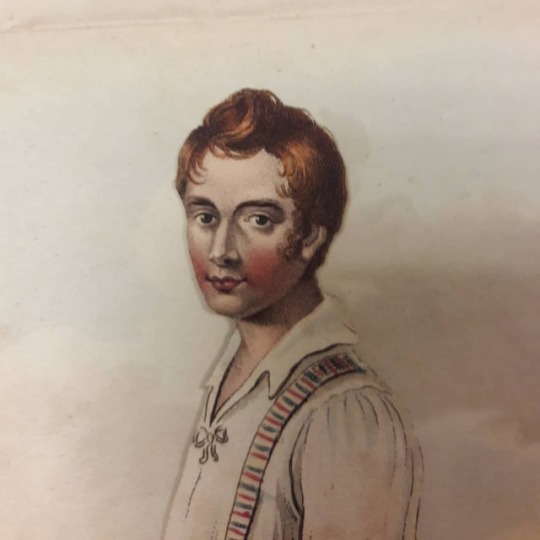
Spent the morning hanging out with this gentleman. #exhibit #goodlifechoices (at The University of Illinois Rare Book & Manuscript Library) https://www.instagram.com/p/BoPIgwllaTK/?utm_source=ig_tumblr_share&igshid=ct8owbn12rzf
1 note
·
View note
Photo





This One’s For You ~
… . @illinoisrbml!
Yesterday, @illinoisrbml, the Tumblr blog for the Rare Book & Manuscript Library of the University of Illinois at Urbana-Champaign, made a Halloween post on Edward Gorey’s 1979 publication Dracula: A Toy Theatre, which we reblogged, noting that not only do we hold this publication, but our former Captain Alison came back to guest curate our October mini-show Unforgettably Gorey and made a model of three scenes from the Dracula stage set by photocopying pages from this book and constructing them into 3D sets. We said we might follow up by photographing the installation and posting it on Tumblr. @illinoisrbml responded enthusiastically, so here it is! [sorry for the glare of the glass case].
We’re showing one of the three “silo cases” in The Grind coffee shop housing the show, which includes three scenes from Gorey’s stage designs: Dr. John Seward’s Library; Lucy Westenra’s Boudoir; Dracula’s Crypt/Dungeon. Nice job, Alison! The QR code on the label is a link to our own Tumblr post on this book that we featured in October 2015.
This show comes down this Friday (Nov. 3), so if you’re in town and want to see it, you’ve only got a day and a half left!
So for all you do, @illinoisrbml, this post’s for you!
View some of our other followers we have recognized.
#This One's for You#illinoisrbml#edward gorey#dracula#stage design#stage sets#library exhibition#alison#pagefrights
78 notes
·
View notes
Text
Apply for UIC Library Special Collections Graduate Student Fellowships 2018-2019
The University of Illinois at Chicago (UIC) Library is offering Graduate Student Fellowships to further research using the holdings of Special Collections and University Archives.
Special Collections at the Richard J. Daley Library houses manuscripts, rare books, photographs, and artifacts on the social, political, and cultural history of Chicago. The Library of the Health Sciences-Chicago Special Collections documents the city’s rich history as a center for the education and practice of the medical arts. Premier collections include the papers of Richard J. Daley, the Chicago Urban League, the Century of Progress, exemplars of 21st century design, and the Chicago settlement house movement. More information is available at library.uic.edu/home/collections/special-collections-university-archives.
An interdisciplinary committee will review the applications, and selections will be announced in early May 2018. Up to three Fellowships will be awarded.
DEADLINE FOR APPLICATIONS: January 16, 2018
AWARD CYCLE: The UIC academic year begins August 16 and ends August 15. For this awards cycle, projects may begin any time after acceptance in May 2018 and end by August 15, 2019.
ELIGIBILITY: The award is open to graduate students enrolled in graduate degree programs at UIC. All academic disciplines are eligible. Preference is given to applicants who plan to use UIC political manuscript collections. Past UIC Special Collections fellows are eligible.
AWARD: $2,000 for one semester during the 2017/18 or 2018/19 academic years. The Fellowship does not include a tuition waiver. The stipend will be paid in one installment one at the beginning of the fellowship semester.
REPORTING REQUIREMENTS: Fellows are required to submit a midterm report and final report. Fellows may be invited to give a presentation on their research.
APPLICATIONS: A completed application consists of the following components:
A cover letter that includes a title and description of your research project and preferred semester of the fellowship.
Statement of purpose (300-500 words): Explain the nature of your project and the sources you expect to use in the UIC Library’s Special Collections and University Archives.
Proposed outcome of research such as a paper, thesis, etc. (100 to 200 words): Briefly explain how this fellowship will aid in the completion of your project.
Curriculum vitae.
Letter of recommendation from your advisor evaluating your proposed project. The letter may be sent separately, but in your application please include the name, email address, and affiliation of the person who will be writing the recommendation.
Electronic submissions only:
Library Human Resources
The University of Illinois at Chicago
[email protected]
For questions, please contact [email protected].
The UIC Library Special Collections Graduate Student Fellowships are generously funded by the Richard J. Daley Collection Committee.
9 notes
·
View notes
Text
68 Cultural, Historical and Scientific Collections You Can Explore Online
https://sciencespies.com/news/68-cultural-historical-and-scientific-collections-you-can-explore-online/
68 Cultural, Historical and Scientific Collections You Can Explore Online
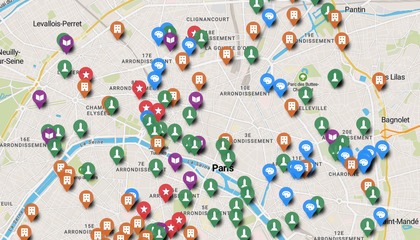
SMITHSONIANMAG.COM |
March 23, 2020, 8 a.m.
As efforts to contain the effects of the COVID-19 crisis ramp up, millions of people around the globe are social distancing and self-quarantining themselves in their own homes. To support those in search of diversion from the relentless news cycle, Smithsonian magazine has compiled a collection of 68 online culture, history and science collections you can browse from the comfort of your living room. Whether you’re in the mood to virtually explore ancient Rome, read past presidents’ personal papers or download coloring pages from dozens of international cultural institutions, this roundup has you covered. Listings are bolded and organized by field. (See Smithsonian’s lists of museums you can virtually visit, ways to virtually experience the Smithsonian Institution and Smithsonian educational resources for additional inspiration.)
History

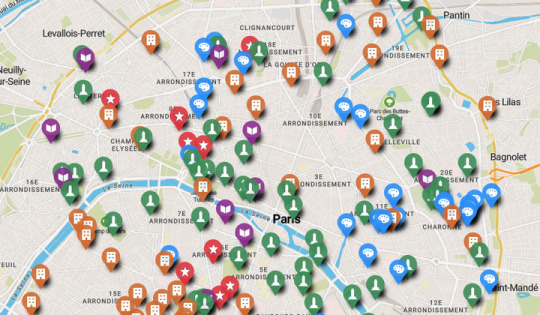


This map of Paris highlights women’s cultural contributions to the French capital.
(Screenshot via Parisian Matrimony)
History lovers may not be able to tour the Smithsonian’s National Museum of American History, the British Museum or the Hermitage in person, but digital history resources spanning time periods, continents and countless topics can provide some respite from these travel woes.
Step back in time via Ancient Athens 3-D or Rome Reborn, then cross the Mediterranean into Egypt for an in-depth look at the famed Nefertiti bust. Other immersive historical offerings include a virtual reality museum featuring five shipwrecked vessels; the Heritage on Edge portal, which tracks climate change’s impact on five Unesco World Heritage Sites; a 3-D digital rendering of Japan’s Shuri Castle, which was ravaged by fire in October 2019; a 3-D scan of the bullets that killed President John F. Kennedy; Below the Surface, a multimedia project that traces Amsterdam’s history through excavated artifacts; and a Sketchfab collection of around 1,700 open-access cultural heritage models, from the Abraham Lincoln Mills life mask to the entrance gates of Ireland’s Menlo Castle and a Scottish boat-building school.
Interactive maps are another option for individuals seeking higher-tech experiences. Google Earth’s Celebrating Indigenous Languages platform spotlights dialects at risk of disappearing, while Parisian Matrimony tracks women’s cultural contributions to the French capital. Mapping the Gay Guides, a newly launched public history initiative, draws on more than 30,000 listings compiled between 1965 and 1980 to visualize American queer spaces’ evolution over time.
Those with more macabre tastes may want to peruse the Survey of Scottish Witchcraft, a tool that visualizes thousands of sites linked with Scotland’s 16th- and 17th-century witch hunts, or the London Medieval Murder Map, which catalogs 142 brutal 14th-century homicides. (In one particularly colorful incident, a man named John de Eddeworth avenged his murdered brother by stabbing the killer “five times with his sword, three times on the back of his head, once on the left side, and once under his left ear.”) Lower-tech maps, including the Library of Congress’ collection of 38,234 digitized travelogues and English king George III’s recently digitized private library of more than 55,000 maps, charts, prints and manuals, are also available.
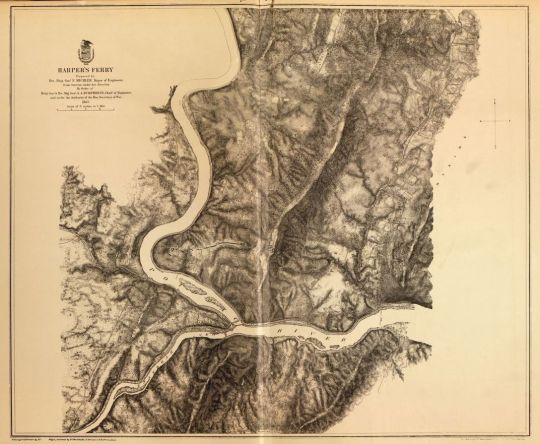
Civil War map of Harper’s Ferry, West Virginia
(Library of Congress)
In the realm of information-heavy databases, highlights range from an index of searchable records that sheds light on New York’s ties to slavery to the Digital Panopticon’s descriptions of 75,688 Victorian-era convicts’ tattoos and the Getty’s archive of 6,000 photos from the waning days of the Ottoman Empire. Troves of digitized documents, meanwhile, run the gamut from historic Mexican cookbooks to a 15th-century British manners book that warns children against picking “thyne errys” and “thy nostrellys,” 155 Persian language texts spanning nearly 1,000 years, one million pages of 16th- through 20th-century content formerly deemed obscene, and the famed Dead Sea Scrolls.
Those hoping to read more personal narratives can check out photographs, prints and papers related to Queen Victoria’s husband, Prince Albert; the only surviving Arabic slave narrative written in the U.S.; and papers penned by such prominent politicians as Theodore Roosevelt, Woodrow Wilson, Warren G. Harding, Benjamin Franklin and Alexander Hamilton. Other public figures whose private lives endure in the digital sphere include civil rights activist Rosa Parks, baseball star Babe Ruth, landscape architect Frederick Law Olmsted, and explorer David Livingstone (as recorded in the diary of his chief attendant, Jacob Wainwright).
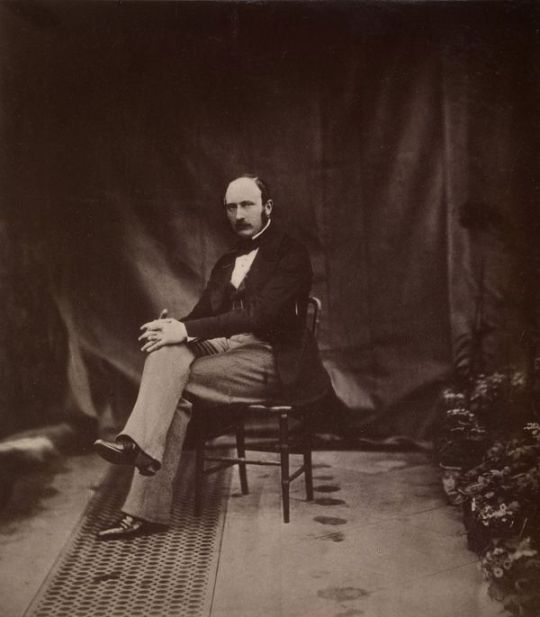
After Roger Fenton, Prince Albert, May 1854, 1889 copy of the original
(Royal Collection Trust / © Her Majesty Queen Elizabeth II 2019)

John Singer Sargent, Frederick Law Olmsted, 1895
(Public domain via Wikimedia Commons)
Arts and Culture

Edward Hopper, Nighthawks, 1942
(Courtesy of the Art Institute of Chicago)
In recent years, museums have increasingly turned to digitization as a tool for widening access to their collections. Among the major cultural institutions with digitized—and often open access—offerings are the Smithsonian, which released 2.8 million images into the public domain earlier this year; Paris Musées, which oversees 14 major museums in France’s capital; nonprofit organization Art U.K.; the Art Institute of Chicago; Taiwan’s National Palace Museum; the Metropolitan Museum of the Art; the National Gallery of Art in Washington, D.C.; the Getty; the Wellcome Library; the Museum of New Zealand; and the Uffizi Galleries. Examples of artworks, artifacts and texts available for download include British psychiatric institutions’ 18th- through 20th-century records, Vincent van Gogh’s The Bedroom and Han dynasty jades.
In addition to digitizing broader collections, many museums have curated archives dedicated to specific topics: The Kunsthaus Zürich has an extensive trove of Dada documents that defy the movement’s long-held association with ephemerality, while the Delaware Art Museum has a portal of papers associated with the Pre-Raphaelite Brotherhood. Illinois State University’s Milner Library offers a digital collection dedicated to the history of circus. The San Francisco-based Letterform Archive has a digital archive of typographical artifacts. And Chicago’s Newberry Library provides online access to more than 200,000 images documenting the history of early America and westward expansion, including watercolors and colored pencil drawings by 19th- and 20th-century Lakota children.

The portal allows users to narrow down search results by “design-specific” terms, as well as geographic, chronological parameters.
(Courtesy of Letterform Archive)
Two giants of the digital cultural sphere—Google Arts & Culture and the Library of Congress—are each home to a dizzying number of virtual resources. The former offers experiences covering 3,000 years of fashion, Pieter Bruegel the Elder’s unseen masterpieces, Latino culture in the U.S., Banksy’s most famous murals, Vermeer’s surviving paintings, armor through the ages, Easter Island and many more topics. The latter has, among others, collections of rare children’s books, Taiwanese watercolors and Chinese texts, braille sheet music, travel posters, presidential portraits, baseball cards, and images of cats and dogs. See the library’s database of digital collections for a more exhaustive overview.
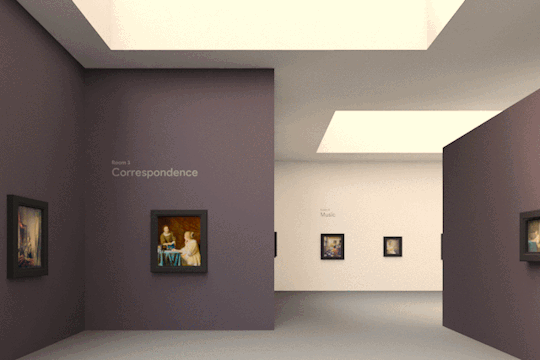
The virtual museum features seven rooms focused on themes such as correspondence, music and flirtation.
(Pocket Gallery / Google Arts & Culture)
Other out-of-the-box ideas include using an app that guides readers through Chaucer’s Canterbury Tales; downloading free coloring pages compiled during the annual #ColorOurCollections campaign—offerings range from a zany 1920s advertisement for butter to medical drawings, book illustrations and a wartime nurse recruitment poster; or reading the New York Public Library’s interactive Insta Novel versions of Alice’s Adventures in Wonderland, Charlotte Perkins Gilman’s “The Yellow Wallpaper” and Kafka’s The Metamorphosis.

Aubrey Beardsley’s illustration for Salome by Oscar Wilde
(Courtesy of the British Library)
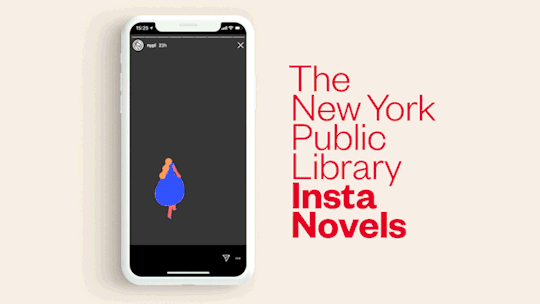
The NYPL’s Insta Novels are available via Instagram.
(Courtesy of the New York Public Library)
Another option for individuals with ample time on their hands is transcribing historical documents and data. The Smithsonian Transcription Center is always looking for volunteers to log field notes, diaries, ledgers, manuscripts and biodiversity specimen labels. Other offerings include the Library of Congress’ By the People project, which asks users to transcribe collections related to women’s suffrage, Rosa Parks, Abraham Lincoln and Spanish law; the Newberry Library’s Transcribing Faith portal, which seeks volunteers eager to analyze early modern manuscripts; and the Citizen Archivist, which asks participants to tag, transcribe and add comments to the National Archives’ records.
Science
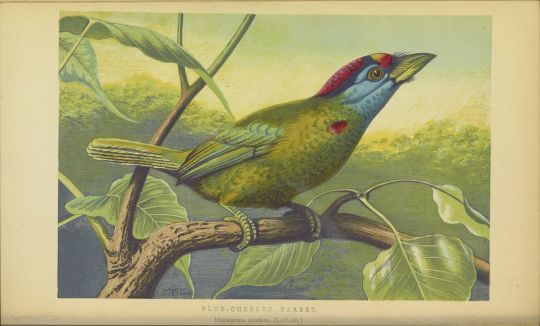
The blue-throated barbet, illustrated here in 1871, is native to southern Asia.
(Courtesy of the Biodiversity Heritage Library)
Flowers, fungi and fauna abound in digitized renderings of the natural world. The open-access Biodiversity Heritage Library, for instance, highlights more than 150,000 illustrations ranging from animal sketches to historical diagrams and botanical studies; the Watercolor World, a portal created to serve as a “visual record of a pre-photography planet,” showcases more than 80,000 paintings of landscapes, seascapes, buildings, animals, plants, ordinary people and historical events.
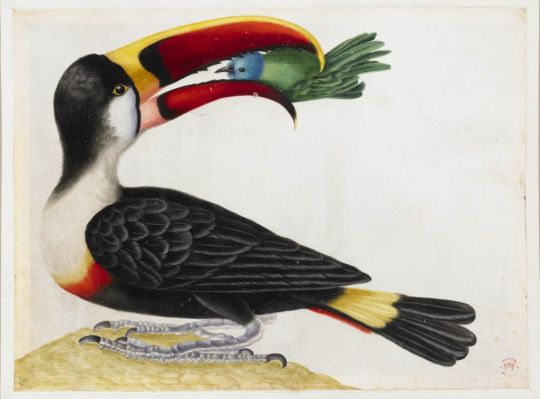
Maria Sibylla Merian, Untitled (Toucan), 1701–1705
(© Trustees of the British Museum)
Other digital science resources include an interactive map that lets users plug in their address to see how it’s changed over the past 750 million years, a collection of unsettling sounds from outer space, Cambridge University’s Isaac Newton papers, Charles Darwin’s manuscripts, hundreds of case files written by a pair of 17th-century astrologers and physicians, a map that visualizes all 21 successful moon landings, and a medical pop-up book dating to the 17th century.
#News
1 note
·
View note
Text

Bold Poets and rash Painters may aspire With pen and pencill to describe my Faire, Alas; their arts in the performance fayle, And reach not that divine Original, Some Shadd’wy glimpse they may present to view, And this is all poore humane art Can doe▪
346J J.B. Gent.
The young lovers guide,
or, The unsuccessful amours of Philabius, a country lover; set forth in several kind epistles, writ by him to his beautious-unkind mistress. Teaching lover
s how to comport themselves with resignation in their love-disasters. With The answer of Helena to Paris, by a country shepherdess. As also, The sixth Æneid and fourth eclogue of Virgil, both newly translated by J.B. Gent.
London : Printed and are to be Sold by the Booksellers of London, 1699. $3,500
Octavo, A4, B-G8,H6 I2( lacking 3&’4) (A1, frontispiece Present; I3&’4, advertisements lacking ) inches [8], 116, [4] p. : The frontispiece is signed: M· Vander Gucht. scul:. 1660-1725,
This copy is bound in original paneled sheep with spine cracking but cords holding Strong.
A very rare slyly misogynistic “guide’ for what turns out be emotional turmoil and Love-Disasters !
Writ by Philabius to Venus, his Planetary Ascendant.
Dear Mother Venus!
I must style you so.
From you descended, tho’ unhappy Beau.
You are my Astral Mother; at my birth
Your pow’rful Influence bore the sway on Earth
From my Ascendent: being sprung from you,
I hop’d Success where-ever I should woo.
Your Pow’r in Heav’n and Earth prevails, shall I,
A Son of yours, by you forsaken die?
Twenty long Months now I have lov’d a Fair,
And all my Courtship’s ending in Despair.
All Earthly Beauties, scatter’d here and there,
From you, their Source, derive the Charms they bear.
Wing (2nd ed.), B131; Arber’s Term cat.; III 142
Copies – Brit.Isles : British Library
Cambridge University St. John’s College
Oxford University, Bodleian Library
Copies – N.America : Folger Shakespeare
Harvard Houghton Library
Henry E. Huntington
Newberry
UCLA, Clark Memorial Library
University of Illinois
Engraved frontispiece of the Mistress holding a fan, title within double rule border, 4-pages of publisher`s advertisements at the end Contemporary calf (worn). . FIRST EDITION. . The author remains unknown.
)0(
347J Thomas Frewen (1704-1791)
Hand written collection of Epitaphs and Monumental Inscriptions, principally in Sussex.

Manuscript on paper p. 21 dated ‘Thomas F. Frewen 1741.’ $3,800
Duodecimo. 7 in. x 4.5 inches A10, B14, C10. plus two folded epitaphs such in the binding! This is bound in a beautiful green vellum wallet binding.
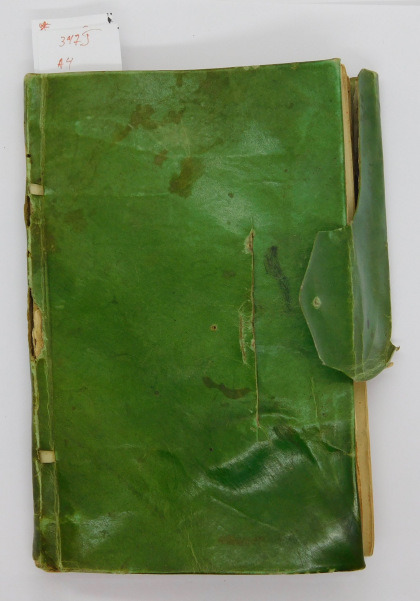
With the numbers in pencil from the Phillipps Library 7073 & 6982
Sir Thomas Phillipps, 1st Baronet [3]
(2 July 1792 – 6 February 1872), was an English antiquary and book collector who amassed the largest collection of manuscript material in the 19th century. He was an illegitimate son of a textile manufacturer and inherited a substantial estate, which he spent almost entirely on vellum manuscripts and, when out of funds, borrowed heavily to buy manuscripts, thereby putting his family deep into debt. Phillipps recorded in an early catalogue that his collection was instigated by reading various accounts of the destruction of valuable manuscripts. Such was his devotion that he acquired some 40,000 printed books and 60,000 manuscripts, arguably the largest collection a single individual has created, and coined the term “vello-maniac”to describe his obsession, which is more commonly termed bibliomania. Dictionary of National Biography, 1885-1900, Volume 45 Phillipps, Thomas
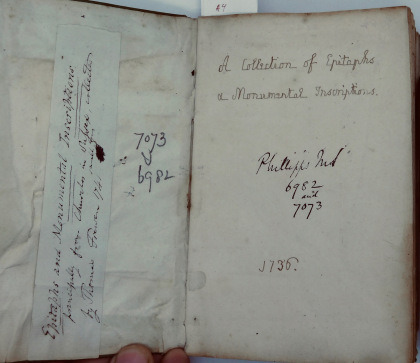
Frewen, Thomas (1704-1791) Physician
THOMAS Frewen M.D. (1704–1791), physician, was born in 1704. He practised as a surgeon and apothecary at Rye in Sussex, and afterwards as a physician at Lewes, having obtained the M.D. degree previous to 1755. He became known as one of the first in this country to adopt the practice of inoculation with small-pox. In his essay on ‘The Practice and Theory of Inoculation’ (Lond. 1749) he narrates his experience in three hundred and fifty cases, only one having died by the small-pox so induced. The common sort of people, he says, were averse to inoculation, and ‘disputed about the lawfulness of propagating diseases’—the very ground on which small-pox inoculation was made penal a century later (1842). The more refined studies of our speculative adepts in philosophy, he says, have let them into the secret that the small-pox and many other diseases are propagated by means of animalcula hatched from eggs lodged in the hairs, pores, &c. of human bodies. In 1759 he published another short essay on small-pox, ‘Reasons against an opinion that a person infected with the Small-pox may be cured by Antidote without incurring the Distemper.’ The opinion was that of Boerhaave, Cheyne, and others, that the development of small-pox after exposure to infection could be checked by a timely use of the æthiops mineral. Frewen’s argument was that many persons ordinarily escape small-pox ‘who had been supposed to be in the greatest danger of taking it,’ and that the æthiops mineral was irrelevant. His other work, ‘Physiologia’ (Lond. 1780), is a considerable treatise applying the doctrines of Boerhaave to some diseases. One of his principles is:
‘Wherever nature has fixed a pleasure, we may take it for granted she there enjoins a duty; and something is to be done either for the individual or for the species.’
He died at Northiam in Sussex, on 14 June 1791, aged 86.
This Manuscript plus the two folded leaves copies 27 different inscriptions made by Frewen. The penultimate one is dated 1741.
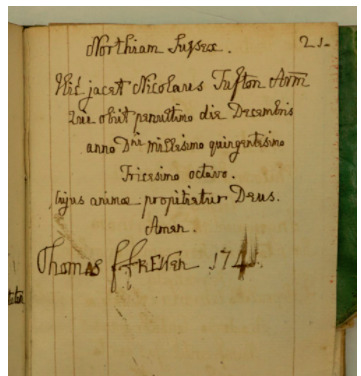
Here are a few .
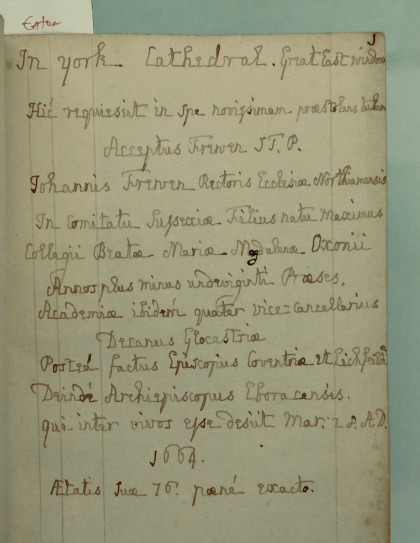
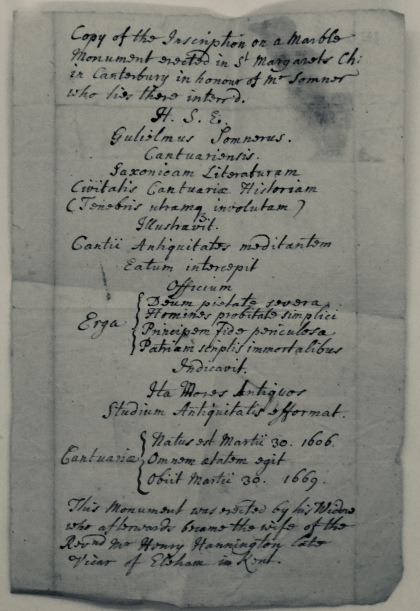

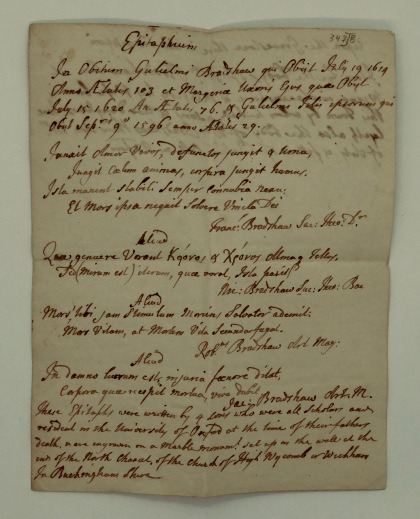
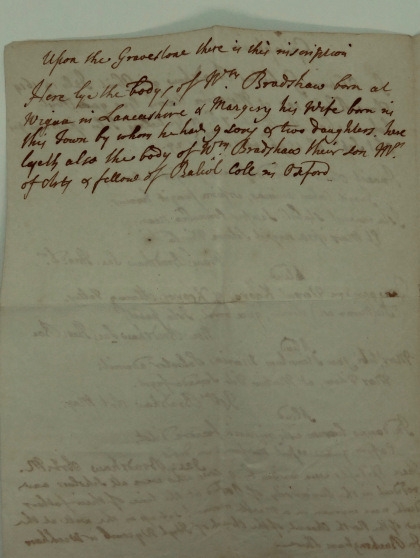
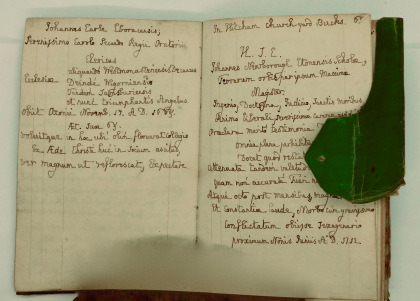
The summary includes a brief description of the collection(s) (usually including the covering dates of the collection), the name of the archive where they are held, and reference information to help you find the collection.
[Gent. Mag.; Giles Watts’s Letter to Dr. Frewen on his behaviour in the case of Mr. Rootes, surgeon, Lond. 1755.]Collections

1)c1770: Encheiridion technicum in re medica Cambridge University Library: Department of Manuscripts and University Archives Add 6857
2) In Papers Royal Society See HMC MS papers of British scientists 1600-1940, 1982
3) 1749-55: prescription book Cambridge University Library: Department of Manuscripts and University Archives Palmer NRA 38777 Palmer
ESTC TITLES
1) Frewen. A just and plain vindication of the late Dr. Frewen, London : printed for M. Cooper, 1743.
2) Frewen. A letter in answer to Dr. Watts. London : printed for W. Owen, and E. Baker, 1756.
3) Frewen. Physiologia: London : printed for J. Bew, in Pater-Noster-Row; and W. Lee, jun. at Lewes, MDCCLXXX. [1780]
4) Frewen., The practice and theory of inoculation. With an account of its success. In a letter to a friend. London : for S. Austen, 1749.
5) Frewen. Some reasons given against an opinion that a person infected with the small-pox may be cured by a London : printed for J. Wilkie, at the Bible, in St. Paul’s Church-Yard, MDCCLIX. [1759]
Today’s books just catalogued. 346J J.B. Gent. The young lovers guide, or, The unsuccessful amours of Philabius, a country lover; set forth in several kind epistles, writ by him to his beautious-unkind mistress.
#1699#17th century courtship#Eiptaphs#green vellum#Insccriptions#love-disasters#Manuscript#Philabius to Venus#Sir Thomas Phillipps#The young lovers guide
0 notes
Photo

Dudley Randall, Ballad of Birmingham, Designed by Shirley Woodson, Broadside No. 1, Broadside Press, Detroit, MI, 1965 ['Broadside Press: Poetry to the People', Collection of the Smithsonian National Museum of African American History and Culture, Smithsonian Institution, Washington, DC. © Dudley Randall Literary Estate/Rare Book & Manuscript Library, University of Illinois at Urbana-Champaign]
#graphic design#poetry#broadside#dudley randall#shirley woodson#carole robertson#addie mae collins#cynthia wesley#denise mcnair#broadside press#national museum of african american history and culture#smithsonian institution#university of illinois rare book & manuscript library#1960s
21 notes
·
View notes
Text
Roger Ebert's Typewriter on Display at University of Illinois | Chaz's Journal
Roger Ebert’s Typewriter on Display at University of Illinois | Chaz’s Journal
[ad_1]

by
The Editors
June 27, 2019
|
Print Page
Tweet
Roger Ebert‘s typewriter is currently on display at the University of Illinois at Urbana-Champaign, as part of the Rare Book & Manuscript Library exhibit, “Writers & Their Tools: Parchment-Paper-Processors.” It features many typewriters previously belonging to literary giants and trailblazing journalists, some of whom are among the…
View On WordPress
0 notes
Text
Books of Hours: Devotional and Decorative Practices
Developing out of increased veneration of the Virgin Mary that occurred throughout Western Europe in the eleventh and twelfth centuries, Books of Hours are devotional texts that allowed the average person to model their daily approach to worship after the ordained clergy. The genre receives its name from the organizational structure of the book, which contains liturgical readings for each of the canonical hours of the Divine Office: Matins, Lauds, Prime, Terce, Sext, None, Vespers, and Compline. In the following centuries, Books of Hours would become the most frequently copied text, and was often the only book a family would own. Spanning the transition from manuscript to print technology, Books of Hours not only provide extensive insight into medieval illumination but also illustrate the development of a genre across evolving materials forms. The Rare Book & Manuscript Library is home to several examples of both manuscript and print Books of Hours whose elaborate decoration and intriguing content invite closer inspection.

A richly detailed manuscript version of the text, the Lyte Book of Hours, created circa 1390, features full page illustrated miniatures like this depiction of Saint Margaret emerging from the belly of the dragon. Named for the Lyte family, who inscribed generations of names into the front page of the book, this Book of Hours exemplifies how readers altered and engaged with the text. In the Calendar section—the typical start to Books of Hours that lists out the saints’ days—the month of December shows only minuscule flakes of red ink where the name of St. Thomas Becket should be, reflecting Henry VIII’s desire for the archbishop of Canterbury to be forgotten. Also, at one point the Latin shifts to indicate female ownership, with the text referring to the reader as the Lord’s “handmaid”. These physical and textual changes, although minor, demonstrate the ongoing customization that was common for Books of Hours. Call number: Pre-1650 MS 0076

An excellent example of how early Books of Hours were made to look like manuscripts, the title page of the Heures de Nostre Dame features a printed image that was filled in with pigment by hand. Although the book was printed by Antoine Chappiel, the illustration was carried out by the French printer and illuminator, Germain Hardouyn, whose own printer’s mark graces the title page.
Throughout the text manuscript illumination is used by Hardouyn to create the impression of a justified text block, filling in any spaces that would make the right side of the text appear jagged.

Like in a manuscript Book of Hours, illuminated initials are used to guide the reader through the passage. The large margins of the page signify the high quality (and price) of the book, indicating a preference for aesthetics over reducing costs by fitting more words onto the page. A less lavish Book of Hours might have text running all the way to the outer edges of the page. Additionally, the book was printed on vellum rather than paper, which indicates the printer’s intention for this Book of Hours replicate the luxury of a manuscript edition rather than a mass-produced printed copy. Call number: Incunabula 264.02 C28ho150-
To learn more about the genre, take a look at the Book of Hours LibGuide, which provides resources for secondary research, describes typical sections within Books of Hours, and gives a finding aid for the Books of Hours housed at the University of Illinois Rare Book & Manuscript Library.
35 notes
·
View notes
Text
Gwendolyn Brooks
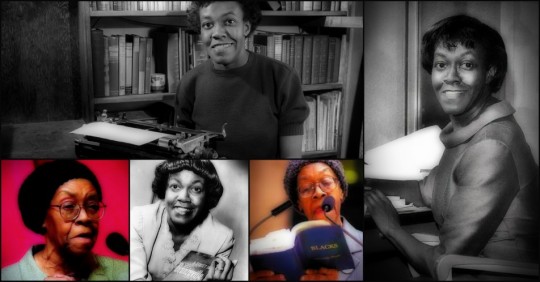

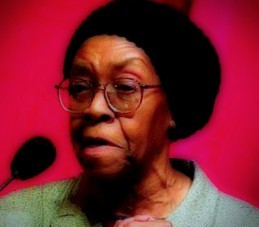

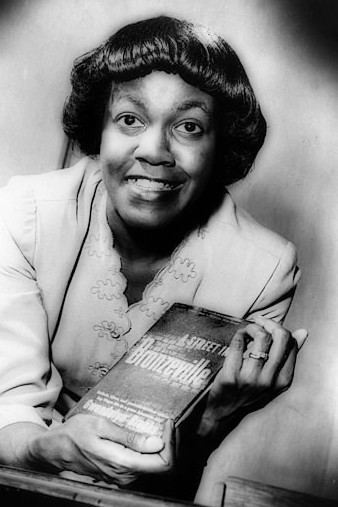

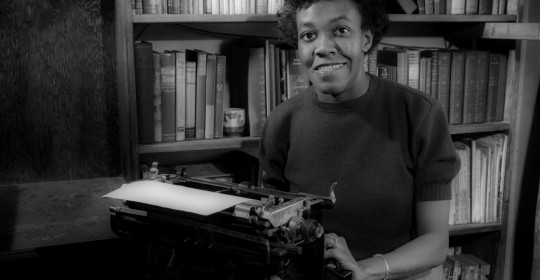
Gwendolyn Elizabeth Brooks (June 7, 1917 – December 3, 2000) was an American poet, author, and teacher. She was the recipient of many awards for her work and influence; including the Pulitzer Prize for Poetry on May 1, 1950, making her the first African American woman to receive that award.
Throughout her career Brooks received many more honors. She was appointed Poet Laureate of Illinois in 1968, a position held until her death, and Poet Laureate Consultant in Poetry to the Library of Congress in 1985.
Early life
Gwendolyn Elizabeth Brooks was born on June 7, 1917, in Topeka, Kansas, and died on December 3, 2000 in Chicago, IL. She was the first child of David Anderson Brooks and Keziah (Wims) Brooks. Her father was a janitor for a music company who had hoped to pursue a career as a doctor but sacrificed that aspiration to get married and raise a family. Her mother was a school teacher as well as a concert pianist trained in classical music. Family lore held that her paternal grandfather had escaped slavery to join the Union forces during the American Civil War.
When Brooks was six weeks old, her family moved to Chicago during the Great Migration; from then on, Chicago remained her home. According to biographer Kenny Jackson Williams, Brooks first attended a prestigious integrated high school in the city with a predominantly white student body, Hyde Park High School, transferred to the all-black Wendell Phillips High School, and then moved to the integrated Englewood High School. After completing high school, she graduated in 1936 from Wilson Junior College, now known as Kennedy-King College. Due to the social dynamics of the various schools, in conjunction with time period in which she attended them, Brooks faced racial injustice that over time contributed to her understanding of the prejudice and bias in established systems and dominant institutions in her own surroundings as well as ever relevant mindset of the country.
Brooks began writing at an early age and her mother encouraged her saying, ''You are going to be the lady Paul Laurence Dunbar."
After these early educational experiences, Brooks never pursued a four-year degree because she knew she wanted to be a writer and considered it unnecessary. "I am not a scholar," she later said. "I'm just a writer who loves to write and will always write." She worked as a typist to support herself while she pursued her career.
She would closely identify with Chicago for the rest of her life. In a 1994 interview, she remarked on this,
"(L)iving in the city, I wrote differently than I would have if I had been raised in Topeka, KS...I am an organic Chicagoan. Living there has given me a multiplicity of characters to aspire for. I hope to live there the rest of my days. That's my headquarters.
Career
Writing
Brooks published her first poem, "Eventide", in a children's magazine, American Childhood, when she was 13 years old. By the age of sixteen she had already written and published approximately seventy-five poems. She received commendations on her poetic work and encouragement from James Weldon Johnson and later, Langston Hughes, both well-known writers with whom she kept communication with and whose readings she attended in Chicago. At seventeen, she started submitting her work to "Lights and Shadows," the poetry column of the Chicago Defender, an African-American newspaper. Her poems, many published while she attended Wilson Junior College, ranged in style from traditional ballads and sonnets to poems using blues rhythms in free verse.
Her characters were often drawn from the inner city life that Brooks knew well. She said, "I lived in a small second-floor apartment at the corner, and I could look first on one side and then the other. There was my material."
By 1941, Brooks was taking part in poetry workshops. A particularly influential one was organized by Inez Cunningham Stark, an affluent white woman with a strong literary background. Stark offered writing workshops to African-Americans on Chicago's South Side, which Brooks attended. It was here she gained momentum in finding her voice and a deeper knowledge of the techniques of her predecessors. Renowned poet Langston Hughes stopped by the workshop and heard Brooks read "The Ballad of Pearl May Lee." Brooks continued to work diligently at her writing and growing the community of artists and writers around her as her poetry began to be taken more seriously. She and her husband frequently threw parties at their apartment at 623 E. 63rd Street and it was in the kitchenette of that apartment that Brooks hosted a party for her friend and mentor Langston Hughes. Once he unexpectedly dropped in and famously shared a meal of mustard greens, ham hocks, and candied sweet potatoes with Brooks and her husband Henry Blakely.
Brooks' published her first book of poetry, A Street in Bronzeville (1945), with Harper and Row, after strong show of support to the publisher from author Richard Wright. He said to the editors who solicited his opinion on Brooks' work:
"There is no self-pity here, not a striving for effects. She takes hold of reality as it is and renders it faithfully.... She easily catches the pathos of petty destinies; the whimper of the wounded; the tiny accidents that plague the lives of the desperately poor, and the problem of color prejudice among Negroes."
The book earned instant critical acclaim for its authentic and textured portraits of life in Bronzeville. Brooks later said it was a glowing review by Paul Engle in the Chicago Tribune that "initiated My Reputation." Engle stated that Brooks' poems were no more "Negro poetry" than Robert Frost's work was "white poetry." Brooks received her first Guggenheim Fellowship in 1946 and was included as one of the “Ten Young Women of the Year” in Mademoiselle magazine.
In 1953, Brooks published her first and only narrative book, a novella titled Maud Martha, which in a series of thirty-four small vignettes, follows the life of a black woman named Maud Martha in detail as she moved about life from childhood to adulthood. It tells the story of "a woman with doubts about herself and where and how she fits into the world. Maud's concern is not so much that she is inferior but that she is perceived as being ugly," states author Harry B. Shaw in his book, Gwendolyn Brooks. Maud suffers prejudice and discrimination not only from white individuals but also from black individuals who have lighter skin tones than hers, something that is direct reference to Brooks' personal experience. Eventually, Maud stands up for herself by turning her back on a patronizing and racist store clerk. "The book is ... about the triumph of the lowly," Shaw comments.
In 1967, the year of Hughes' death, Brooks attended the Second Black Writers' Conference at Nashville's Fisk University. Here, according to one version of events, she met activists and artists such as Imamu Amiri Baraka, Don L. Lee and others who exposed her to new black cultural nationalism. Recent studies argue that she had been involved in leftist politics in Chicago for many years and, under the pressures of McCarthyism, adopted a black nationalist posture as a means of distancing herself from her prior political connections. Brooks' experience at the conference inspired many of her subsequent literary activities. She taught creative writing to some of Chicago's Blackstone Rangers, otherwise a violent criminal gang. In 1968 she published one of her most famous poems, In the Mecca, a long poem about a mother's search for her lost child in a Chicago apartment building. The poem was nominated for the National Book Award for poetry.
Brooks' second book of poetry, Annie Allen (1950), focused on the life and experiences of a young Black girl as she grew into womanhood in the Bronzeville neighborhood of Chicago. The book was awarded the Pulitzer Prize for poetry; she also was awarded Poetry magazine's Eunice Tietjens Prize.
Her autobiographical Report From Part One, including reminiscences, interviews, photographs and vignettes, came out in 1972, and Report From Part Two was published in 1995, when she was almost 80.
Teaching
Brooks said her first teaching experience was at the University of Chicago when she was invited by author Frank London Brown to teach a course in American literature. It was the beginning of her lifelong commitment to sharing poetry and teaching writing.
Brooks taught extensively around the country and held posts at Columbia College Chicago, Northeastern Illinois University, Chicago State University, Elmhurst College, Columbia University, City College of New York, and the University of Wisconsin–Madison.
On May 1, 1996, Brooks returned to her birthplace of Topeka, Kansas. She gave the keynote speech for the Third Annual Kaw Valley Girl Scout Council's "Women of Distinction Banquet and String of Pearls Auction."
Archives
The Rare Book & Manuscript Library (University of Illinois at Urbana-Champaign) acquired Brooks' archives from her daughter Nora. In addition, the Bancroft Library at UC Berkeley has a collection of her personal papers, especially from 1950 to 1989.
Family life
In 1939, Brooks married Henry Lowington Blakely, Jr. They had two children: Henry Lowington Blakely III, born on October 10, 1940; and Nora Blakely, born in 1951.
From mid-1961 to late-1964, Henry III served in the U.S. Marine Corps, first at Marine Corps Recruit Depot San Diego and then at Marine Corps Air Station Kaneohe Bay. During this time, Brooks mentored his fiancée, Kathleen Hardiman, today known as anthropologist Kathleen Rand Reed, in writing poetry. Upon his return, Blakely and Hardiman married in 1965. Brooks had so enjoyed the mentoring relationship that she began to engage more frequently in that role with the new generation of young black poets.
In the year 1990, her works were given a permanent home when Chicago State University established the Gwendolyn Brooks Center for Black Literature and Creative Writing on campus. On her eightieth birthday, in 1997, Brooks was honored with tributes from Chicago to Washington, D.C. Gwendolyn Brooks died of cancer at her Chicago home on December 3, 2000.
Honors and legacy
1946, Guggenheim Fellow in Poetry
1946, American Academy of Arts & Letters Award
1950, Pulitzer Prize in Poetry
1968, appointed Poet Laureate of Illinois, a position she held until her death in 2000
1976, the Shelley Memorial Award of the Poetry Society of America
1985, selected as the Consultant in Poetry to the Library of Congress, an honorary one-year position whose title was renamed the next year to Poet Laureate
1988, inducted into the National Women's Hall of Fame
1989, recipient, Life Time Achievement Award from the National Endowment for the Arts.
1989, awarded the Robert Frost Medal for lifetime achievement by the Poetry Society of America
1992, awarded the Aiken Taylor Award by the Sewanee Review
1994, chosen as the National Endowment for the Humanities' Jefferson Lecturer, one of the highest honors in American literature and the highest award in the humanities given by the federal government.
1994, Recipient of the National Book Foundations's Medal for Distinguished Contribution to American Letters
1995, presented with the National Medal of Arts
1995, honored as the first Woman of the Year chosen by the Harvard Black Men's Forum
1995, received the Chicago History Museum "Making History Award" for Distinction in Literature
1997, awarded the Order of Lincoln award from The Lincoln Academy of Illinois, the highest honor granted by the State of Illinois
Brooks also received more than 75 honorary degrees from colleges and universities worldwide.
Legacy
1970: "For Sadie and Maud" by Eleanor Holmes Norton, included in Sisterhood is Powerful: An Anthology of Writings From The Women's Liberation Movement (1970), quotes all of Brooks' poem "Sadie and Maud"
1970: Gwendolyn Brooks Cultural Center, Western Illinois University, Macomb, Illinois
1995: Gwendolyn Brooks Elementary School, Aurora, Illinois
1990: Gwendolyn Brooks Center for Black Literature and Creative Writing, Chicago State University
2001: Gwendolyn Brooks College Preparatory Academy, Chicago, Illinois
2001: Gwendolyn Brooks Middle School, Harvey, Illinois
2002: Gwendolyn Brooks Middle School, Oak Park, Illinois
2003: Gwendolyn Brooks Illinois State Library, Springfield, Illinois
2002: 100 Greatest African Americans
2004 Gwendolyn Brooks Park named by the Chicago Park District, 4542 S. Greenwood Ave. Chicago IL 60653
2005: Gwendolyn Brooks Middle School, Bolingbrook, Illinois
2012: Honored on a United States' postage stamp.
Wikipedia
12 notes
·
View notes
Photo

Oh hey there replica piquet cards back from the printer in time for Friday's Recency Frost Fair themed holiday party holiday party (3-5pm, @illinoisRBML). Please join us! (at The University of Illinois Rare Book & Manuscript Library)
12 notes
·
View notes